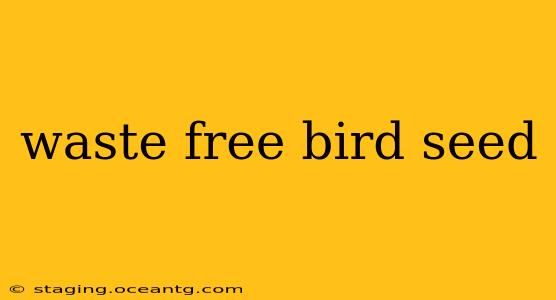Feeding birds is a rewarding hobby, connecting us with nature and supporting local wildlife. But what about the waste? Scattered seeds, spoiled mixes, and plastic packaging contribute to environmental problems. This guide explores how to make bird feeding more sustainable and waste-free.
What are the main sources of waste from birdseed?
A significant portion of birdseed waste stems from several key areas:
- Spoiled seed: Improper storage leading to moldy or rancid seed.
- Uneaten seed: Birds don't consume everything scattered, leading to ground waste and potential rodent attraction.
- Packaging: Many birdseed products come in plastic packaging that ends up in landfills.
- Seed spillage: Poorly designed feeders can result in substantial seed spillage.
How can I reduce wasted birdseed?
Reducing waste in bird feeding requires a multi-pronged approach:
1. Choosing the Right Birdseed
- Species-specific blends: Opt for seed mixes tailored to the bird species common in your area. This minimizes uneaten seeds left behind. A blend targeted towards cardinals, for instance, will likely contain more sunflower seeds than a general mix.
- High-quality seed: Choose seed from reputable brands that prioritize quality control to reduce spoilage.
- Buy in bulk (responsibly): Buying in bulk can be cost-effective and reduce packaging waste, provided you have adequate storage to prevent spoilage.
2. Proper Storage of Birdseed
- Cool, dry place: Store birdseed in airtight containers in a cool, dry location to prevent moisture damage and insect infestations. A metal container works best.
- Small quantities: Buy only what you can reasonably use within a few months to prevent spoilage.
3. Selecting the Right Bird Feeder
- Well-designed feeders: Choose feeders designed to minimize seed spillage. Consider features like baffles or covered trays.
- Feeder type: Different feeders cater to different bird species and feeding preferences. Experiment to find what works best in your area and minimizes waste.
- Regular cleaning: Regularly clean feeders to prevent the buildup of mold, bacteria, and disease.
4. Reducing Seed Spillage
- Ground feeding vs. hanging feeders: Consider the species you wish to attract and their feeding preferences. Some birds thrive on ground feeders, while others prefer hanging options.
- Placement: Position feeders away from areas that promote seed scattering, such as overhanging branches or windy spots.
- Clean-up: Regularly sweep up spilled seed to prevent waste and rodent attraction.
5. Sustainable Packaging
- Look for eco-friendly options: Increasingly, companies offer birdseed in recycled or biodegradable packaging. Support these companies to encourage more sustainable practices.
- Refill options: Consider buying from local stores that offer bulk refills, reducing your reliance on single-use packaging.
What can I do with leftover birdseed?
- Homemade birdseed cakes: Combine leftover seed with other ingredients (like suet or peanut butter) to create tasty treats.
- Compost: If your seed is completely dry and hasn’t been affected by moisture or pests, it can be composted.
How do I prevent rodents from accessing my birdseed?
Rodent control is crucial for waste reduction and hygiene. Use feeders with rodent guards and store seed in rodent-proof containers. Regularly clean up spilled seed to eliminate attractants.
By implementing these waste-free strategies, you can enjoy bird feeding while minimizing your environmental impact. It's a win-win situation for both you and the birds.
